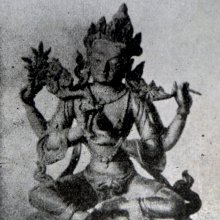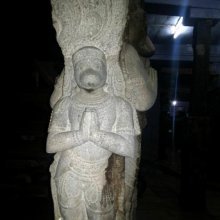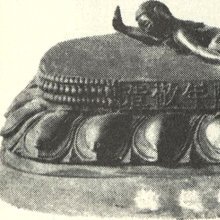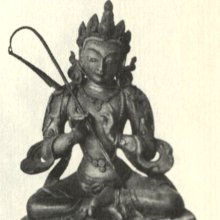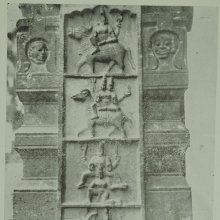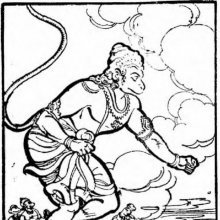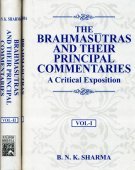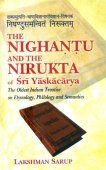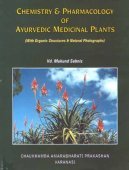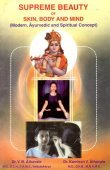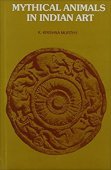Vayu, Vāyu: 57 definitions
Introduction:
Vayu means something in Buddhism, Pali, Hinduism, Sanskrit, Jainism, Prakrit, the history of ancient India, Marathi, Hindi, Tamil. If you want to know the exact meaning, history, etymology or English translation of this term then check out the descriptions on this page. Add your comment or reference to a book if you want to contribute to this summary article.
Images (photo gallery)
(+6 more images available)
In Hinduism
Ayurveda (science of life)
Source: archive.org: Sushruta samhita, Volume IIThis vital Vāyu (nerve force), which courses through the body, is self-begotten in its origin, and is regarded as identical with the divine energy of eternal life (God), inasmuch as it is unconditional and absolute in its actions and effects, eternal and self-origined, and is subtile and all-pervading (like the sky and the atoms). It is the primary factor, which determines the principle of cause and effect in all forms of created things, whether mobile or immobile. It is so called (Vāyu) from the fact of its coursing (skr. Vā—to move) throughout the universe.
It determines the growth, origin and disintegration of all animated organisms, and as such, it receives the homage of all created beings. Although invisible in itself, yet its works are patent or manifest. It is cold, light, mobile, dry and piercing, and follows a transverse course. It is characterised by the two attributes (proper-sensibles or Gunas) of sound and touch. It abounds in the fundamental quality of Rajas (principle of cohesion and action), is of inconceivable prowess, propels all the deranged or obstructing prinicples (Doshas) in the organism, (or in other words, is primarily concerned with the deranged principles of the body which are pathogenic in their actions).
It is instantaneous in its action, and radiates or courses through the organism in constant currents. It has its primary field of action in the intestinal tract (Pakvādhāna) and the rectum (Guda). In its deranged state, it is the principal factor, which, (in combination with the deranged Pittam and Kapham), lies at the root of all diseases, and is accordingly termed the king of diseases (Rogarāt).
Source: archive.org: Sushruta samhita, Volume IThe term Vayu may not only be rightly interpreted to mean the nerve force, but is often extended to include any kind of electro-motor or molecular force (as when we speak of the Vayu of the soil), though the term is loosely applied now to signify gas or air.
The Vāyu is a self-origined principle in the human organism.
Source: gurumukhi.ru: Ayurveda glossary of termsVāyu (वायु):—A synonym of Vāta, one of the three bodily Doṣas, that is predominant of Vāyu and Ākāśa Mahābhūtas. This is a vital biological force that performs the fuctions like all sensory perceptions, all motor activities, and higher mental activities. This is of five subtypes: Prāṇa, Vyāna, Udāna, Samāna and Apāna. The major sites of distribution of Vāyu are: Large intestine, pelvis, extremities, ears, bones and skin. The attributes of Vāyu are: Rūkṣa (dry), Laghu (light), Śīta (cold), Khara (rough), Sūkṣma (minute), Cala (mobile).

Āyurveda (आयुर्वेद, ayurveda) is a branch of Indian science dealing with medicine, herbalism, taxology, anatomy, surgery, alchemy and related topics. Traditional practice of Āyurveda in ancient India dates back to at least the first millenium BC. Literature is commonly written in Sanskrit using various poetic metres.
Natyashastra (theatrics and dramaturgy)
Source: archive.org: The mirror of gesture (abhinaya-darpana)One of the Deva-vibhāvana (hands that indicate the forms which accord with the character and actions of Brahmā and other Devas).—Vayu: left hand–Ardha-patāka, right hand–Arāla.

Natyashastra (नाट्यशास्त्र, nāṭyaśāstra) refers to both the ancient Indian tradition (shastra) of performing arts, (natya—theatrics, drama, dance, music), as well as the name of a Sanskrit work dealing with these subjects. It also teaches the rules for composing Dramatic plays (nataka), construction and performance of Theater, and Poetic works (kavya).
Yoga (school of philosophy)
Source: Wisdom Library: YogaVāyu (वायु, “air”):—One of the five gross elements assigned as a zone (or sphere) to the human body (bhūtamaṇḍala), according the Yogatattva-upaniṣad. The element air is seated between the heart and the eyebrows. Air is represented by a hexagon (ṣaṭkoṇa), the colour black (kṛṣṇa) and the syllable ya (य). The deity presiding over this region is Īśvara.
Source: Brill: Śaivism and the Tantric Traditions (yoga)Vāyu (वायु) refers to the “breath”, according to the Amṛtasiddhi, a 12th-century text belonging to the Haṭhayoga textual tradition.—Accordingly, “It is taught that when the breath (vāyu) moves bindu moves; the mind of he whose bindu is moving is restless”.
Source: ORA: Amanaska (king of all yogas): A Critical Edition and Annotated Translation by Jason Birch1) Vāyu (वायु) or Vāyutattva refers to the “(elemental power of) wind” and as one of the “five elemental powers”, represents one of the various signs and paranormal powers (siddhi) experienced by the Yoga practicioner, according to the Amanaska Yoga treatise (presented in the form of a dialogue between Īśvara and Vāmadeva).—The last fifty-two verses of the Amanaska’s first chapter describe a temporal sequence of psychosomatic signs and paranormal powers (siddhi) brought about by absorption (laya). In the Amanaska, The five elemental powers are, [e.g., wind (vāyu-tattva)], [...].
2) Vāyu (वायु) refers to the “breath”, according to the Yogayājñavalkya, an ancient Sanskrit text from the 8th century dealing with the eight components of Yoga in over 500 verses.—Accordingly, [while describing a practice of breathing]: “Having drawn the breath (vāyu) in through the tongue [whose edges are curled up to form a tube], the man who constantly drinks [the breath this way] does not [suffer from] fatigue or [excessive] heat [in the body] and all [minor] diseases are cured. Having drawn in the breath at the junctures of the day or an hour before sunrise, he who drinks it [thus] for three months, good lady, [gains] eloquent speech and within six months of practice, he is freed from all serious diseases”.
3) Vāyu (वायु) refers to the “winds (of the dissolution)”, according to verse 6.21.14 of the Mokṣopāya.—Accordingly, as Bhuśuṇḍa said to Vasiṣṭha: “[...] When the suns blaze and the mountains have become rubble, then, having performed concentration on the water element, I remain with my mind steady. When the lords of the mountains have been pulverized and the winds of the dissolution (pralaya-vāyu) blow, then, having performed concentration on the earth element, I remain unmoving in the ether. [...]”.

Yoga is originally considered a branch of Hindu philosophy (astika), but both ancient and modern Yoga combine the physical, mental and spiritual. Yoga teaches various physical techniques also known as āsanas (postures), used for various purposes (eg., meditation, contemplation, relaxation).
Vastushastra (architecture)
Source: Wisdom Library: Vāstu-śāstraAir (वायु, vāyu) is one of the five primary elements (pañcabhūta) forming the basic components of the world, according to Vāstu-śāstra literature. It is because of the presence and balance of these five elements that our planet thrives with life.
Source: Brill: Śaivism and the Tantric Traditions (architecture)Vāyu (वायु) (or Anila) refers to one of the deities to be installed in the ground plan for the construction of houses, according to the Bṛhatkālottara, chapter 112 (the vāstuyāga-paṭala).—The plan for the construction is always in the form of a square. That square is divided into a grid of cells (padas). [...] Once these padas have been laid out, deities [e.g., Vāyu] are installed in them. In the most common pattern 45 deities are installed.
Vāyu as a doorway deity is associated with the Nakṣatra called Āṣāḍha and the consequence is uccāṭana. [...] The Mayasaṃgraha (verse 5.156-187) describes a design for a 9-by-9-part pura, a residential complex for a community and its lead figure. [...] This record lists a place for perfumes at Vāyu (gandhavahe).

Vastushastra (वास्तुशास्त्र, vāstuśāstra) refers to the ancient Indian science (shastra) of architecture (vastu), dealing with topics such architecture, sculpture, town-building, fort building and various other constructions. Vastu also deals with the philosophy of the architectural relation with the cosmic universe.
Purana and Itihasa (epic history)
Source: archive.org: Puranic Encyclopedia1) Vāyu (वायु).—One of the eight guardians of the world. (Dikpālakas). General information. Vāyu was born from the breath of Viśvapuruṣa. (Ṛgveda 10, 90). Tvaṣṭā was the son in-law of Vāyu. The eight dikpālakas are Indra, Vahni (Fire), Yama, Nirṛti, Varuṇa, Vāyu, Kubera and Śiva. Vāyu is the guardian of the North West zone. The palace of Bhagavān Vāyu is known as Gandhavatī. (See full article at Story of Vāyu from the Puranic encyclopaedia by Vettam Mani)
2) Vāyu (वायु).—An ancient hermit of India. It is mentioned in Mahābhārata, Śānti Parva, Chapter 47, Stanza 9, that this hermit visited Bhīṣma on his bed of arrows.
Source: archive.org: Shiva Purana - English TranslationVāyu (वायु) refers to the “wind” (mentioned as the most important of those [elements] with velocity—vega), according to the Śivapurāṇa 2.5.2 (“The Prayer of the gods).—Accordingly, as the Gods eulogized Śiva: “[...] Among the sense-organs you are the mind; among the charitable gifts you are the gift of freedom from fear; among the sanctifying and life-giving agents you are considered the waters. Among all acquisitions you are the acquisition of sons; among those with velocity you are the wind (vāyu) [vāyurvegavatāmasi]; among the routine sacred rites you are the Sandhyā worship. [...]”.
Source: Cologne Digital Sanskrit Dictionaries: The Purana Index1a) Vāyu (वायु).—A God and father of Ilā;1 and Mudā clan of Apsarasas: presented Pṛthu with cāmaras worshipped through prāṇāyama in Śākadvīpa;2 A Lokapāla and father of Bhīma. Took part in the Devāsura wars and killed the Asuras. Deprived of his force by the Asuras;3 set out on a black antelope against Kṛṣṇa taking pārijāta, but returned afraid of him;4 his city was visited by Arjuna in search of the dead child of a Dvārakā Brāhmaṇa;5 Born of Ākāśa: the wind-god loved Añjanā and gave birth to Hanumān: overlord of the winds, formless creatures and of time. Presiding deity of Bhuvarloka and hence Bhuvaspati (also Mātariśva). Addressed by the sages engaged in sacrifice to speak on lokāloka;6 narrates the fourth pāda of the brahmāṇḍa purāṇa,7 reported to Umā in penance of a lady in her chamber little knowing her to be Ādi in disguise;8 worship of;9 Icon of, mounted on a black deer,10 a sthāna of Rudra;11 father of Manojava and Bhīma;12 Kṛṣṇa's messenger to Indra.13
- 1) Bhāgavata-purāṇa IV. 10. 2; 14. 26.
- 2) Ib. V. 15. 15; 20. 27.
- 3) Ib. VIII. 5. 19; 10. 26; 11. 1 and 42; IX. 22. 27. Matsya-purāṇa 31. 12; 46. 9. 266. 24; Vāyu-purāṇa 99. 244.
- 4) Bhāgavata-purāṇa X. [65 (v) 44]: [66 (v) 27-32]; Matsya-purāṇa 148. 60-61.
- 5) Ib. X. 89. 44; Brahmāṇḍa-purāṇa IV. 33. 67.
- 6) Ib. II. 20. 1 and 7; 25. 5-14; III. 7. 23, 224-5, 296; 8. 12; IV. 2. 20; 195-7, 212, 245-6.
- 7) Ib. IV. 1. 227; 4. 44.
- 8) Matsya-purāṇa 156. 39.
- 9) Ib. 236, 5; 253. 24; 265. 39 and 41. 268. 12.
- 10) Ib. 261. 19; 289. 6.
- 11) Viṣṇu-purāṇa I. 8. 7.
- 12) Ib. I. 8. 11; IV. 20. 40.
- 13) Ib. V. 21. 14-17; 37. 16-28.
1b) Is a transformation of ākāśa with the two qualities of śabda and sparśa. Its subtle element is sparśa from which came tejas;1 it is prāṇa, apāna and samāna;2 role of, in sustaining life.3
1c) A Vasu: a son of Dharma and Sudevī.*
- * Matsya-purāṇa 171. 47.
1d) A son of Anuhrāda;1 the lord of sabda, ākāśa and bala,2 the appointed father of Vṛkodara;3 presented Skanda with the banners of the cuckoo and hen.4
1e) A tirtha sacred to, in the Sarasvatī.*
- * Bhāgavata-purāṇa III. 1. 22.
Vāyu (वायु) is a name mentioned in the Mahābhārata (cf. IX.44.40) and represents one of the many proper names used for people and places. Note: The Mahābhārata (mentioning Vāyu) is a Sanskrit epic poem consisting of 100,000 ślokas (metrical verses) and is over 2000 years old.
Source: Shodhganga: The saurapurana - a critical studyVāyu (वायु) is the name of a gross element which originates from Sparśatanmātra which originates from Ākāśa through its spontaneous self-modification, according to the 10th century Saurapurāṇa: one of the various Upapurāṇas depicting Śaivism.—[...] Again the bhūtādi covers up the śabda-tanmātra and the ākāśa differentiated form it as the gross element. The ākāśa being thus conditioned, produces spontaneously by self modification the sparśatanmātra which produces immediately and directly the gross vāyu. The bhūtādi again covers up the ākāśa, śabda-tanmātra, sparśa-tanmātra and the differentiated vāyu which then produces the rūpa-tanmātra which immediately produces the gross light (teja). The sparśatanmātra and the vāyu cover up the rūpatanmātra.

The Purana (पुराण, purāṇas) refers to Sanskrit literature preserving ancient India’s vast cultural history, including historical legends, religious ceremonies, various arts and sciences. The eighteen mahapuranas total over 400,000 shlokas (metrical couplets) and date to at least several centuries BCE.
Vaisheshika (school of philosophy)
Source: Wikipedia: VaisheshikaVāyu (वायु, “air”) is one of the nine dravyas (‘substances’), according to the Vaiśeṣika-sūtras. These dravyas are considered as a category of padārtha (“metaphysical correlate”). These padārthas represent everything that exists which can be cognized and named. Together with their subdivisions, they attempt to explain the nature of the universe and the existence of living beings. Vāyu is also regarded as one of the five bhūtas (‘elements’) possessing a specific quality making it cognizable.
Source: Shodhganga: A study of Nyāya-vaiśeṣika categories (vaisesika)Vāyu (वायु, “air”) refers to one of the nine substances (dravya) according to the Nyāya-Vaiśeṣika school of philosophy (cf. Vaiśeṣikasūtra 1.1.5, Saptapadārthī, Tarkabhāṣā and Bhāṣāpariccheda). Vāyu is the fourth dravya. Annaṃbhaṭṭa says that air possesses the quality of touch and is devoid of colour. If it is said that air is only devoid of colour, then the definition will be over-pervasive to the ākāśa as ākāśa is also devoid of colour. To remove this over-pervasiveness, it is defined as possessing touch (sparśavat), ākāśa as is not touchable. Again if air (vāyu) is defined as possessing touch only, then it will be over-pervasive to pṛthivī (earth), ap (water) and tejas (light).Therefore, vāyu is defined without colour. Pṛthivī, ap etc. are possessed of touch but not without colour.
Just like earth, water and fire, air (vāyu) is also two-fold–eternal and noneternal. The atoms of air are eternal and composite aerial substances are non-eternal. Again non-eternal is divided into three kinds–body (śarīra), sense-organ (indriya) and object (viṣaya). Body is found in the world of wind-God. Organ is that through which one feels touch and it is stretched over the whole body. Objects are the cause of the shaking of trees. There is another variety of air, which is called breath. In the sight, it is nothing but this wind is moving inside the body. According to Praśastapāda, breath is the fourth kind of vāyu. It is different from the body, sense-organ and object. But Annaṃbhaṭṭa includes this breath under objects. The five types of breath are prāṇa, apāna, samāna, udāna and vyāna.
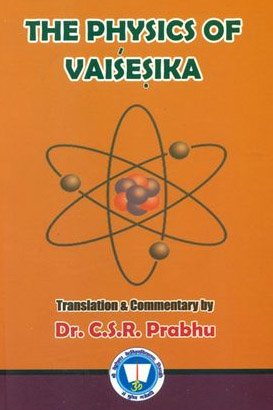
Vaisheshika (वैशेषिक, vaiśeṣika) refers to a school of orthodox Hindu philosophy (astika), drawing its subject-matter from the Upanishads. Vaisheshika deals with subjects such as logic, epistemology, philosophy and expounds concepts similar to Buddhism in nature
Pancaratra (worship of Nārāyaṇa)
Source: Wisdom Library: PāñcarātraVāyu (वायु) refers to an aspect of nṛsiṃha (‘man-lion’), according to the Vihagendra-saṃhitā 4.17, which mentions seventy-four forms (inlcuding twenty forms of vyūha). He is also known as Vāyunṛsiṃha or Vāyunarasiṃha. Nṛsiṃha is a Tantric deity and refers to the furious (ugra) incarnation of Viṣṇu.
The 15th-century Vihagendra-saṃhīta is a canonical text of the Pāñcarātra corpus and, in twenty-four chapters, deals primarely with meditation on mantras and sacrificial oblations.

Pancaratra (पाञ्चरात्र, pāñcarātra) represents a tradition of Hinduism where Narayana is revered and worshipped. Closeley related to Vaishnavism, the Pancaratra literature includes various Agamas and tantras incorporating many Vaishnava philosophies.
Shaktism (Shakta philosophy)
Source: Wisdom Library: ŚāktismVāyu (वायु) refers to one of the 53 gods to be worshipped in the northern quarter and given pāyasa (rice boiled in milk) according to the Vāstuyāga rite in Śaktism (cf. Śāradātilaka-tantra III-V). The worship of these 53 gods happens after assigning them to one of the 64 compartment while constructing a Balimaṇḍapa. Vāstu is the name of a prodigious demon, who was killed by 53 gods (e.g., Vāyu).
Source: Google Books: ManthanabhairavatantramVāyu (वायु) or Vāyutattva refers to the “wind element”, according to the Manthānabhairavatantra, a vast sprawling work that belongs to a corpus of Tantric texts concerned with the worship of the goddess Kubjikā.—Accordingly, “Earth, Water, and Fire as well as Wind and Space—these are the five great sacred seats that give rise to Day and Night. (The seat named after) the syllable OṂ is the Earth Principle. Water is the venerable Pūrṇagiryaka. The Fire Principle is called Jāla. Wind [i.e., vāyu-tattva] is the venerable Kāmarūpaka. Space is said to be Tisra. The seats that have arisen from the Kula (the matrix of energies) are five. [...] Fire is above. Water is below. Slanted (to the side) above is Wind. Earth, in the middle, is the immobile Vidyā and Space is everywhere”.
Source: Brill: Śaivism and the Tantric Traditions (shaktism)Vāyu (वायु) refers to the “vital air”, according to the King Vatsarāja’s Pūjāstuti called the Kāmasiddhistuti (also Vāmakeśvarīstuti), guiding one through the worship of the Goddess Nityā.—Accordingly, “[...] O Goddess! With your energy the sun burns, the moon expands the immortal essence with his beams, and here in our body the vital functions glimmer under the control of the vital air (vāyu-vaśa). For, without you none can function at all”.

Shakta (शाक्त, śākta) or Shaktism (śāktism) represents a tradition of Hinduism where the Goddess (Devi) is revered and worshipped. Shakta literature includes a range of scriptures, including various Agamas and Tantras, although its roots may be traced back to the Vedas.
Vyakarana (Sanskrit grammar)
Source: Wikisource: A dictionary of Sanskrit grammarVāyu (वायु).—Air or प्राण (prāṇa), which is believed to spring up from the root of the navel and become a cause (even a material cause according to some scholars) of sound of four kinds produced at four different places, the last kind being audible to us; cf. प्राणो वणीनभिव्यज्य वर्णेष्वेवोपलीयते (prāṇo vaṇīnabhivyajya varṇeṣvevopalīyate) Vakyapadiya I.116;cf. also R.Pr.XIII. 13, V.Pr. I.7-9; T.Pr.II.2: Siksa of Panini st. 6.

Vyakarana (व्याकरण, vyākaraṇa) refers to Sanskrit grammar and represents one of the six additional sciences (vedanga) to be studied along with the Vedas. Vyakarana concerns itself with the rules of Sanskrit grammar and linguistic analysis in order to establish the correct context of words and sentences.
Shilpashastra (iconography)
Source: Shodhganga: The significance of the mūla-beras (śilpa)Vāyu (वायु) is one of the Aṣṭadikpālaka (“eight guardians of the directions”), as defined according to texts dealing with śilpa (arts and crafs), known as śilpaśāstras.—In dance, when the right hand of the dancer assumes arāla-hasta and the left hand of the dancer assumes ardhapatāka-hasta, it is vāyu-hasta. In iconography, both the hands of Vāyu hold flags. Therefore, there is similarity in the hasta used in dance and the position of the hands found in the deity Vāyu. But the figure of Vāyu chiseled is found in kartarīmukha-hasta. Thus, if the dancer uses the kartarīmukha-mudrā then it would be more apt. These deities are believed to have appeared in sculptures first and then came into dancing forms. If that is the case, then it would be better to adapt the apt mudrās found in the icons while presenting it in dance.
Source: Shodhganga: Elements of Art and Architecture in the Trtiyakhanda of the Visnudharmottarapurana (shilpa)Vāyu (वायु) iconography is described in the Viṣṇudharmottarapurāṇa, an ancient Sanskrit text which (being encyclopedic in nature) deals with a variety of cultural topics such as arts, architecture, music, grammar and astronomy.—According to the Śabdakalpadruma, Vāyu is the lord of the north western side of the globe. According to the Viṣṇudharmottarapurāṇa, the dress of the image of this God should be flowing with the wind. The Śilparatna suggests that the garment of the image of Vāyu should be of variegated colour. The image of Vāyu has abundant of hair and scattered in a well manner. The image of his wife Śivā is also placed in the left side of the image of Vāyu. According to the Viṣṇudharmottarapurāṇa, the image of Pavana is also made along with the image of Vāyu.

Shilpashastra (शिल्पशास्त्र, śilpaśāstra) represents the ancient Indian science (shastra) of creative arts (shilpa) such as sculpture, iconography and painting. Closely related to Vastushastra (architecture), they often share the same literature.
Vedanta (school of philosophy)
Source: Google Books: Studies on the MoksopayaVāyu (वायु) refers to “wind”, according to the 10th century Mokṣopāya or Mokṣopāyaśāstra 6.182.13-17.—Accordingly, “With regard to each of [the three:] perceiver (draṣṭṛ), perception (darśana) and perceived objects (dṛśya), the state of mere knowledge is the essence; therefore there is not in the least a difference from it (i.e. knowledge), like a flower in space (is not different from space). (13) What is of the same kind becomes one. Therefore mutual perception [of things] determines their unity. (14) If wood, stones and other [material objects] did not have knowledge as their nature, then there would be a permanent non-perception of these, which would even be nonexistent. (15) When the whole beauty of perceptible objects has but one form of mere knowledge, then, whether it is different or identical, it becomes known through knowledge. (16) This whole [group of] perceptible objects in the world has expanded [as] mere knowledge, just as wind [i.e., vāyu] is mere movement [i.e., spanda-mātra] and the ocean mere water. (17)”.

Vedanta (वेदान्त, vedānta) refers to a school of orthodox Hindu philosophy (astika), drawing its subject-matter from the Upanishads. There are a number of sub-schools of Vedanta, however all of them expound on the basic teaching of the ultimate reality (brahman) and liberation (moksha) of the individual soul (atman).
Kavya (poetry)
Source: Brill: Śaivism and the Tantric Traditions (kavya)Vāyu (वायु) refers to the “wind”, according to Kālidāsa’s Raghuvaṃśa verse 8.90-91.—Accordingly: “'[...] When we are taught that our own body and soul unite and then separate, tell me which wise person should be tormented by separation from the external objects of the senses? Best of the self-controlled! You ought not to become subject to grief like common people. What would be the difference between a tree and a mountain if both shook in the wind (vāyu)?”.

Kavya (काव्य, kavya) refers to Sanskrit poetry, a popular ancient Indian tradition of literature. There have been many Sanskrit poets over the ages, hailing from ancient India and beyond. This topic includes mahakavya, or ‘epic poetry’ and natya, or ‘dramatic poetry’.
Shaivism (Shaiva philosophy)
Source: Brill: Śaivism and the Tantric TraditionsVāyu (वायु) or Prāṇa refers to the “vital airs of the body”, according to the Brahmayāmala-tantra (or Picumata), an early 7th century Śaiva text consisting of twelve-thousand verses.—[The padmamālā-vidhi prescribes installing deities within series of nine, seven and eight lotuses].—While the Brahmayāmala does not treat the lotus garlands as fixtures of a subtle body, it does posit the existence of such structures: the body’s channels (nāḍī) and vital airs (vāyu, prāṇa), for instance, and more pertinently, points known as granthis (“knots” or “joints”). A particular series of nine granthis forms the locus for installing the nine lotuses of the primary padmamālā. That granthis were considered to be anatomical realities is suggested by their treatment as points in the body rather than as objects to be placed/installed in the body or engendered through meditation. [...]

Shaiva (शैव, śaiva) or Shaivism (śaivism) represents a tradition of Hinduism worshiping Shiva as the supreme being. Closely related to Shaktism, Shaiva literature includes a range of scriptures, including Tantras, while the root of this tradition may be traced back to the ancient Vedas.
General definition (in Hinduism)
Source: Wisdom Library: HinduismVāyu (वायु, “air”):—The Lord of the wind;—In Vedic hinduism, he is the regent of the north-western direction and represents the cosmic life breath. He is the universal “spirit” (the impeller of life and the living). He is also the substance and the essence of speech (vāc). As a Vedic deity, he is also the messenger of the gods and the leader of sacrifices. He is known by other names, eg. Vāta, Marut, Anila or Pāvana. He has a son named Hanumān.
Source: Wisdom Library: ĀraṇyakaVāyu (वायु, “wind”) refers to one of the devatāpañcaka (fivefold divinities), defined in the Taittirīya-āraṇyaka 7.7.1. The devatāpañcaka, and other such fivefold divisions, are associated with the elemental aspect (adhibhūta) of the three-fold division of reality (adhibhūta, adhidaiva and adhyātma) which attempts to explain the phenomenal nature of the universe. Adhibhūta denotes all that belongs to the material or elemental creation.
The Taittirīya-āraṇyaka is associated with the Kṛṣṇa-yajurveda and dates from at least the 6th century BCE. It is composed of 10 chapters and discusses vedic rituals and sacrifices (such as the mahāyajña) but also includes the Taittirīya-upaniṣad and the Mahānārāyaṇa-upaniṣad.
Source: Apam Napat: Indian MythologyVayu is one of the principal Devas, and is responsible for the wind. He is very powerful, capable of blowing away mountains with his mighty gusts. His wife is Anjala, and he had many sons. The most famous of those sons is Hanuman, followed by Bheema, whom he begat on Kunti.
Source: WikiPedia: HinduismVayu (वायु): The god of air and wind who is also father of Bhima and Hanuman.
In Buddhism
Theravada (major branch of Buddhism)
Source: Pali Kanon: Pali Proper NamesA deity, whose son was Vijjadhara. See the Samugga Jataka.
Theravāda is a major branch of Buddhism having the the Pali canon (tipitaka) as their canonical literature, which includes the vinaya-pitaka (monastic rules), the sutta-pitaka (Buddhist sermons) and the abhidhamma-pitaka (philosophy and psychology).
Mahayana (major branch of Buddhism)
Source: Wisdom Library: Maha Prajnaparamita SastraVāyu (वायु) refers to the element “wind”, according to the 2nd century Mahāprajñāpāramitāśāstra chapter XLIX.—Accordingly, “some say that, of the four great elements (mahābhūta), the power of the wind (vāyu) is the greatest. Having neither form (rūpa) nor odor (gandha) nor taste (rasa), its mobility (īraṇā) is very great. Just as space (ākāśa) is infinite, so wind too is infinite. The success or failure of giving birth depends on wind. The power (prabhāva) of the great winds shakes the mountains of the trisāhasramahāsāhasralokadhātu. This is why the Buddha says here that the Bodhisattva who wishes to stop the force of the winds with one finger should practice the perfection of wisdom. Why? Because the true nature (dharmatā) of the Prajñāpāramitā is immense (apramāṇa) and infinite (ananta), it can make the finger have such strength”.
By cultivating the Prajñāpāramitā, this great earth (mahāpṛthivī) is reduced to its subtle atoms (paramāṇu). Because the earth element (pṛthivī) possesses color (rūpa), odor (gandha), taste (rasa) and touch (spraṣṭavya), it is heavy (guru) and does not have activity (kriyā) on its own.—Because the water (ap-) element has no taste (rasa), it is superior to earth by means of its movement (calana).—Because the fire (tejas) element has neither odor (gandha) nor taste (rasa), it is superior to water (ap) in its power (prabhāva).—Because the wind (vāyu) element is neither visible (rūpa) nor has it any taste (rasa) or touch (spraṣṭavya), it is superior to fire by means of its movement (īraṇa).—The mind (citta) which has none of these four things [color, taste, smell and touch] has a still greater power.
Source: academia.edu: A Study and Translation of the GaganagañjaparipṛcchāVāyu (वायु) refers to the “wind”, according to the Gaganagañjaparipṛcchā: the eighth chapter of the Mahāsaṃnipāta (a collection of Mahāyāna Buddhist Sūtras).—Accordingly, “[...] Then, the bodhisatva, the great being, Gaganagañja addressed himself to the Lord: [...] (33) How can living beings be supported with Buddha-activities when Buddhas do not appear? (34) [How are the Bodhisattvas] not attached to the thoughts and deeds of all living beings having attained the concentration (samādhi) called the ocean-seal (sāgaramudrā)? (35) [How do the Bodhisattvas] transcend all attachments, their thoughts (citta) being like the wind (vāyu) in the sky (gagana)? [...]’”.

Mahayana (महायान, mahāyāna) is a major branch of Buddhism focusing on the path of a Bodhisattva (spiritual aspirants/ enlightened beings). Extant literature is vast and primarely composed in the Sanskrit language. There are many sūtras of which some of the earliest are the various Prajñāpāramitā sūtras.
Tibetan Buddhism (Vajrayana or tantric Buddhism)
Source: archive.org: The Indian Buddhist IconographyVāyu (वायु) (direction: Vāyu-corner) refers to one of the eight Dikpālas, commonly depicted in Buddhist Iconography, and mentioned in the 11th-century Niṣpannayogāvalī of Mahāpaṇḍita Abhayākara.—His Colour is blue; his Vehicle is the deer; he has two arms
Vāyu is described in the Niṣpannayogāvalī (dharmadhātuvāgīśvara-maṇḍala) as follows:—
Source: academia.edu: The Structure and Meanings of the Heruka Maṇḍala“In the Vāyu corner there is Vāyu riding on a Deer and blue in colour. In his two hands he shows the vātapuṭa (empty fold)”.
[Under Vāyudeva his statuette occurs in the Chinese collection].
Vāyu (वायु) refers to one of the eight direction-guardians (dikpāla) of the Guṇacakra, according to the 10th century Ḍākārṇava chapter 15. Accordingly, the guṇacakra refers to one of the four divisions of the sahaja-puṭa (‘innate layer’), situated within the padma (lotus) in the middle of the Herukamaṇḍala. Vāyu is associated with the charnel grounds (śmaśāna) named Kilikilārava; with the tree (vṛkṣa) named Pārthiva; with the serpent king (nāgendra) named Śaṅkhapāla and with the cloud king (meghendra) named Caṇḍa.
Source: OSU Press: Cakrasamvara SamadhiVāyu (वायु, “wind”) or Vāyudhātu refers to “(the element of) wind” and is associated with Padmanṛtyeśvarī, according to the Cakrasaṃvara Samādhi [i.e., Cakrasamvara Meditation] ritual often performed in combination with the Cakrasaṃvara Samādhi, which refers to the primary pūjā and sādhanā practice of Newah Mahāyāna-Vajrayāna Buddhists in Nepal.—Accordingly, “[...] Mohavajrī in the eyes. Dveṣavajrī in the ears. Īrṣyāvajrī in the nostrils. Rāgavajrī in the mouth. Sūryavajrī in touch. Aiśvaryavajrī in the seat of all senses. The element of earth, Pātanī. The element of water, Māraṇī. The element of fire, Ākarṣaṇī. The element of wind (vāyu-dhātu), Padmanṛtyeśvarī. The element of Space, Padmajvālanī. Thus, the purity of the divinities in the seat of the elements”.

Tibetan Buddhism includes schools such as Nyingma, Kadampa, Kagyu and Gelug. Their primary canon of literature is divided in two broad categories: The Kangyur, which consists of Buddha’s words, and the Tengyur, which includes commentaries from various sources. Esotericism and tantra techniques (vajrayāna) are collected indepently.
General definition (in Buddhism)
Source: Wisdom Library: Dharma-samgrahaVāyu (वायु) refers to the last of the “eight world protectors” (aṣṭalokapāla) as defined in the Dharma-saṃgraha (section 8). The Dharma-samgraha (Dharmasangraha) is an extensive glossary of Buddhist technical terms in Sanskrit (e.g., aṣṭalokapāla and Vāyu). The work is attributed to Nagarguna who lived around the 2nd century A.D.
Vāyu is, besides one of the “eight world protectors” (aṣṭalokapāla), one of the “ten world protectors” (daśalokapāla) and one of the “fourteen world protectors” (caturdaśalokapāla).
Vāyu (“windy”) refers to one of the “eleven tangibles” (spraṣṭavya) as defined in the Dharma-saṃgraha (section 38).
Vāyu (“wind”) refers to one of the “five great elements” (mahābhūta) as well as one of the “six elements” (ṣaḍdhātu), defined in the Dharma-saṃgraha (section 39 and 58 respectively).
In Jainism
General definition (in Jainism)
Source: archive.org: The Jaina IconographyVāyu (वायु) refers to one of the Dikpāla or “guardians of the quarters”, a class of deities within Jainism commonly depicted in Jaina art and iconography.—Vāyu rides a deer according to all Jaina authorities. Some Śvetāmbara texts give him the attribute of a Vajra. others givehim a banner. The Digambara account of him only differs from this in the substitute of a wooden weapon. Vāyu is the guardian or Lord of the North-west quarters.
Source: Encyclopedia of Jainism: Tattvartha Sutra 2: the Category of the livingVāyu (वायु, “air”) refers to one of the five types of immobile beings (sthāvara), according to the 2nd-century Tattvārthasūtra 2.13. The sthāvara is a type of empirical (saṃsārī) soul, or sentient (jīva). The state of empirical souls due to the rise of ‘stationery-body-making karma’/ sthāvara-nāmakarma, having only one type of sense organ namely body and which cannot move around freely are called with stationery bodies (sthāvara), eg., jala.
What is the meaning of air (vāyu)? The crust/layer of the air having no consciousness is called air. What is meant by air-bodied living beings? These are the living beings that have air as their body. How many types of air are there? Four types of air namely air, air bodied, life in air body and life tending towards an air body.
Source: The University of Sydney: A study of the Twelve ReflectionsVāyu (वायु) refers to the “wind”, according to the 11th century Jñānārṇava, a treatise on Jain Yoga in roughly 2200 Sanskrit verses composed by Śubhacandra.—Accordingly, “The rain clouds, wind, sun, moon, earth, ocean and Indra [com.—meghavāyusūryendukṣitisamudrendrāḥ] —those, which are protected by the doctrine, are of service to the whole world. I think, that doctrine, whose progress is unimpeded, has arisen for the benefit of the world of living souls in the guise of world-protectors”.
Synonyms: Pavana.

Jainism is an Indian religion of Dharma whose doctrine revolves around harmlessness (ahimsa) towards every living being. The two major branches (Digambara and Svetambara) of Jainism stimulate self-control (or, shramana, ‘self-reliance’) and spiritual development through a path of peace for the soul to progess to the ultimate goal.
India history and geography
Source: Cologne Digital Sanskrit Dictionaries: Indian Epigraphical GlossaryVāyu.—(IE 7-1-2), ‘fortynine’. Note: vāyu is defined in the “Indian epigraphical glossary” as it can be found on ancient inscriptions commonly written in Sanskrit, Prakrit or Dravidian languages.

The history of India traces the identification of countries, villages, towns and other regions of India, as well as mythology, zoology, royal dynasties, rulers, tribes, local festivities and traditions and regional languages. Ancient India enjoyed religious freedom and encourages the path of Dharma, a concept common to Buddhism, Hinduism, and Jainism.
Languages of India and abroad
Pali-English dictionary
Source: BuddhaSasana: Concise Pali-English Dictionaryvāyu : (nt.) wind; the mobile principle.
Source: Sutta: The Pali Text Society's Pali-English DictionaryVāyu, (Vedic vāya, fr. vā: vāyati2) wind Miln. 385; PvA. 156. See next. (Page 609)

Pali is the language of the Tipiṭaka, which is the sacred canon of Theravāda Buddhism and contains much of the Buddha’s speech. Closeley related to Sanskrit, both languages are used interchangeably between religions.
Marathi-English dictionary
Source: DDSA: The Molesworth Marathi and English Dictionaryvāyu (वायु).—m (S) Wind or air. 2 The deity-personification of wind or air. 3 A vital air of the animal system: also the vital airs collectively. 4 Air considered as one of the humors (vāyu or vāta, kapha, pitta): also disease attributed to the predominance of this humor; viz. flatulence, rheumatism, spasm, cramp &c. Ex. of comp. unmattavāyu, tridōṣavāyu, dhanurvāyu, sandhivāyu, jñānavāyu vāyu sōḍaṇēṃ or mōkaḷā karaṇēṃ To break wind: and -saraṇēṃ or mōkaḷā hōṇēṃ To burst forth or escape. For other phrases see the popular word vārā.
Source: DDSA: The Aryabhusan school dictionary, Marathi-Englishvāyu (वायु).—m Wind or air. Flatulence. Vital airs of the animal system. vāyu sōḍaṇēṃ-mōkaḷā karaṇēṃ Break wind; and saraṇēṃ-mōkaḷā hōṇēṃ Burst forth or escape.
Marathi is an Indo-European language having over 70 million native speakers people in (predominantly) Maharashtra India. Marathi, like many other Indo-Aryan languages, evolved from early forms of Prakrit, which itself is a subset of Sanskrit, one of the most ancient languages of the world.
Sanskrit dictionary
Source: DDSA: The practical Sanskrit-English dictionaryVāyu (वायु).—[vā uṇ yuk ca Uṇādi-sūtra 1.1]
1) Air, wind; वायुर्विधूनयति चम्पकपुष्परेणून् (vāyurvidhūnayati campakapuṣpareṇūn) K. R.; आकाशात्तु विकुर्वाणात् सर्वगन्धवहः शुचिः । बलवाञ्जायते वायुः स वै स्पर्शगुणो मतः (ākāśāttu vikurvāṇāt sarvagandhavahaḥ śuciḥ | balavāñjāyate vāyuḥ sa vai sparśaguṇo mataḥ) || Manusmṛti 1.76. (There are seven courses of wind one above the other :āvahaḥ pravaha- ścaiva saṃvahaścodvahastathā | vivahākhyaḥ parivahaḥ parāvaha iti kramāt ||).
2) The god of wind, the deity supposed to preside over wind, (who is the regent of the north-west quarter).
3) A life-wind or vital air, of which five kinds are enumerated:-प्राण, अपान, समान, व्यान (prāṇa, apāna, samāna, vyāna) and उदान (udāna).
4) Morbid affection or vitiation of the windy humour.
5) Breathing, breath.
6) A mystical Name of the letter य (ya).
Derivable forms: vāyuḥ (वायुः).
Source: Cologne Digital Sanskrit Dictionaries: Edgerton Buddhist Hybrid Sanskrit DictionaryVāyu (वायु).—name of a yakṣa leader: Mahā-Māyūrī 236.17.
Source: Cologne Digital Sanskrit Dictionaries: Shabda-Sagara Sanskrit-English DictionaryVāyu (वायु).—m.
(-yuḥ) 1. Air, wind, or its personified deification. 2. The air of the body, of which five are enumerated, viz. Prana, Samana, Apana, Udana, and Byana. 3. Morbid affection of the windy humour. E. vā to go, uṇ Unadi aff., and yuk augment.
Source: Cologne Digital Sanskrit Dictionaries: Benfey Sanskrit-English DictionaryVāyu (वायु).—[vā + yu], m. 1. Air, wind, [Pañcatantra] 184, 11; its deity, [Mānavadharmaśāstra] 1, 23. 2. The air of the body. 3. Morbid affection of the windy humour.
Source: Cologne Digital Sanskrit Dictionaries: Cappeller Sanskrit-English DictionaryVāyu (वायु).—1. [masculine] wind, air, [especially] vital air (5); the god of wind, [plural] the Maruts.
--- OR ---
Vāyu (वायु).—2. [adjective] tired, languid.
--- OR ---
Vāyu (वायु).—3. [adjective] desirous or desirable.
Source: Cologne Digital Sanskrit Dictionaries: Monier-Williams Sanskrit-English Dictionary1) Vāyu (वायु):—1. vāyu m. ([from] √2. vā) wind, air (as one of the 5 elements; in [Mahābhārata] 7 winds are reckoned), [Ṛg-veda] etc. etc.
2) the god of the wind (often associated with Indra in the Ṛg-veda, as Vāta q.v. with Parjanya, but although of equal rank with Indra, not occupying so prominent a position; in the Puruṣasūkta he is said to have sprung form the breath of Puruṣa, and elsewhere is described as the son-in-law of Tvaṣṭṛ; be is said to move in a shining car drawn by a pair of red or purple horses or by several teams consisting of ninety-nine or a hundred or even a thousand horses cf. ni-yut; he is often made to occupy the same chariot with Indra, and in conjunction with him honoured with the first draught of the Soma libation; he is rarely connected with the Maruts, although in [i, 134, 4], he is said to have begotten them from the rivers of heaven; he is regent of the Nakṣatra Svāti and north-west quarter See loka-pāla), [ib.]
3) breathing, breath, [Vājasaneyi-saṃhitā-prātiśākhya; ĪśUp.]
4) the wind of the body, a vital air (of which 5 are reckoned, viz. prāṇa, apāna, samāna, udāna, and vyāna; or nāga, kūrma, kṛkara, devadatta, and dhanaṃ-jaya), [Harivaṃśa; Sāṃkhyakārikā; Vedāntasāra]
5) (in medicine) the windy humour or any morbid affection of it, [Suśruta]
6) the wind as a kind of demon producing madness, [Kādambarī; Vikramāṅkadeva-carita, by Bilhaṇa] (cf. -grasta)
7) (in [astronomy]) Name of the fourth Muhūrta
8) a mystical Name of the letter ya, [Upaniṣad]
9) Name of a Vasu, [Harivaṃśa]
10) of a Daitya, [ib.]
11) of a king of the Gandharvas, [Viṣṇu-purāṇa]
12) of a Marut, [Rāmāyaṇa]
13) [plural] the Maruts, [Kathāsaritsāgara; Mārkaṇḍeya-purāṇa]
14) 2. vāyu mfn. ([from] √vai) tired, languid, [Ṛg-veda vii, 91, 1.]
15) 3. vāyu mfn. ([from] √vī) desirous, covetous, greedy (for food, applied to calves), [Taittirīya-saṃhitā]
16) desirable, desired by the appetite, [Ṛg-veda]
Source: Cologne Digital Sanskrit Dictionaries: Yates Sanskrit-English Dictionary1) Vāyu (वायु):—(yuḥ) 2. m. Air, wind, air of the body; morbid state of it.
2) sakha(khaḥ) 1. m. Fire.
Source: DDSA: Paia-sadda-mahannavo; a comprehensive Prakrit Hindi dictionary (S)Vāyu (वायु) in the Sanskrit language is related to the Prakrit word: Vāu.
[Sanskrit to German]
Sanskrit, also spelled संस्कृतम् (saṃskṛtam), is an ancient language of India commonly seen as the grandmother of the Indo-European language family (even English!). Closely allied with Prakrit and Pali, Sanskrit is more exhaustive in both grammar and terms and has the most extensive collection of literature in the world, greatly surpassing its sister-languages Greek and Latin.
Hindi dictionary
Source: DDSA: A practical Hindi-English dictionaryVāyu (वायु):—(nf) air, wind; windy humour; wind formation within the system; mythologically, the air-god; -[āśaya] air bladder; -[koṣṭha] गतिwind, fleet; ~[gatika] aerodynamic; ~[gatikī] aerodynamics; ~[grasta] flatulent, affected by wind; ~[dāba] air-pressure; •[māpī] a barometer; -[nivṛtti] cure of windy disorder; -[paṃpa] an air pump; -[baṃdha] an airlock; ~[bala] the air force; -[bhāra] air pressure; ~[bhāramāpī] ([yaṃtra]) the barometer; ~[maṃḍala] atmosphere; ~[māpī] an aerometer; -[mārga] airways; air-route; ~[ruddha] airtight; air-proof; ~[vāhita] airborne; ~[vijñāna] aerology ~[vega] having the velocity of wind; ~[vaijñānika] an aerologist; aerological; ~[śvāsī] air-breather; -[senā] air force; -[sevā] air-service; ~[sainika] an airman; ~[hīna] destitute of wind, windless.
...
Kannada-English dictionary
Source: Alar: Kannada-English corpusVāyu (ವಾಯು):—
1) [noun] air or wind.
2) [noun] air as one of the five basic substance which is believed to constitute all physical matter.
3) [noun] any of the five vital airs of the body.
4) [noun] the Wind-God.
5) [noun] a morbid affection of the windy humour in the body; gout; rheumatism.
6) [noun] (pros.) a metrical foot consisting of two short syllablic instants followed by a long one (uu-); anapaestus.
Kannada is a Dravidian language (as opposed to the Indo-European language family) mainly spoken in the southwestern region of India.
Tamil dictionary
Source: DDSA: University of Madras: Tamil LexiconVāyu (வாயு) noun < vāyu.
1. Wind, air; காற்று. (பிங்கலகண்டு) [karru. (pingalagandu)]
2. An element, one of pañca-pūtam, q.v.; பஞ்சபூதத்து ளொன்று. அதன்கண் வாயு வெளிப்பட்டு [panchaputhathu lonru. athankan vayu velippattu] (மணிமேகலை [manimegalai] 27, 209).
3. Vāyu, the Wind-god, regent of the North-west, one of the aṣṭa-tikku-p-pālakar, q.v.; அஷ்டதிக்குப்பால கருள் வடமேற்கு மூலைக்கு அதிபனான தேவன். [ashdathikkuppala karul vadamerku mulaikku athipanana thevan.]
4. The ten vital airs of the body. See தசவாயு. [thasavayu.] (சிலப்பதிகாரம் அரும்பதவுரை [silappathigaram arumbathavurai] 3, 26, உரை. [urai.])
5. The windy humour, one of tiri-tōṣam, q.v.; திரிதோஷத்துள் ஒன்றான பிணிக் கூறு. [thirithoshathul onrana pinig kuru.]
6. Vāyu, of six kinds, viz., acīraṇa-vāyu, utara-vāyu, karppa-vāyu, tamaraka-vāyu, pārica-vāyu, mēka-vāyu; அசீரணவாயு உதரவாயு கர்ப்பவாயு தமரகவாயு பாரிசவாயு மேகவாயு என்ற அறுவகைப்பட்ட வாதக்கூறு. [asiranavayu utharavayu karppavayu thamaragavayu parisavayu megavayu enra aruvagaippatta vathakkuru.]
7. Flatulence; வயிற்றுப்பொருமல். [vayirrupporumal.]
8. Wind, gas generated in the bowels, etc.; அபானவாயு. [apanavayu.]
9. Gas; இரசாயன சாஸ்திரத்திற் கூறும் காற்றுவகை. [irasayana sasthirathir kurum karruvagai.] Mod.
Tamil is an ancient language of India from the Dravidian family spoken by roughly 250 million people mainly in southern India and Sri Lanka.
See also (Relevant definitions)
Starts with (+244): Vaayu-vaataavaran, Vayu vilankam, Vayu-shvasana, Vayu-vatavarana, Vayu-vilamga, Vayu-vilamgam, Vayu-vilangam, Vayu-vilangam-chettu, Vayubaddha, Vayubaddhaka, Vayubala, Vayubaliga, Vayubhaksha, Vayubhakshaka, Vayubhakshana, Vayubhakshya, Vayubharamapakayantra, Vayubharatistotra, Vayubharya, Vayubhojana.
Ends with (+123): Adevayu, Adhovayu, Aduruvayu, Advayu, Agnivayu, Akalavayu, Amdavayu, Amtravayu, Antaravayu, Antavayu, Anukulavayu, Apanavayu, Ardhamgavayu, Arditavayu, Arputavayu, Ashruvayu, Ashvayu, Avayu, Baddhadhovayu, Bhavayu.
Full-text (+5908): Vayu-vatavarana, Santripta-vayu, Caravayu, Adhovayu, Mahabhuta, Apanavayu, Vayubhakshana, Pranavayu, Sparsha, Vayava, Mahavayu, Vaayu-vaataavaran, Vayudeva, Vayuvaha, Vayupparital, Anila, Vaayu varuna, Vayavya, Vayukonam, Vaayu vilanga.
Relevant text
Search found 228 books and stories containing Vayu, Vāyu, Vaayu; (plurals include: Vayus, Vāyus, Vaayus). You can also click to the full overview containing English textual excerpts. Below are direct links for the most relevant articles:
Rig Veda (translation and commentary) (by H. H. Wilson)
Garga Samhita (English) (by Danavir Goswami)
Verse 2.5.8 < [Chapter 5 - The Liberation of Bakāsura]
Verse 1.12.43 < [Chapter 12 - Description of Śrī Nanda’s Festival]
Verse 2.21.32 < [Chapter 21 - The Rāsa-dance Pastime]
Kena upanishad (Madhva commentary) (by Srisa Chandra Vasu)
Mantra 3.7 < [Book 3 - Tṛtīya-Khaṇḍa]
Mantra 3.8 < [Book 3 - Tṛtīya-Khaṇḍa]
Mantra 4.2 < [Book 4 - Caturtha-Khaṇḍa]
A History of Indian Philosophy Volume 2 (by Surendranath Dasgupta)
Part 9 - Prāṇa and its Control < [Chapter XII - The Philosophy of the Yogavāsiṣṭha]
Part 6 - Vedāntic Cosmology < [Chapter XI - The Śaṅkara School of Vedānta (continued)]
Part 8 - Vāyu, Pitta and Kapha < [Chapter XIII - Speculations in the Medical Schools]
Philosophy of Charaka-samhita (by Asokan. G)
The locations, qualities, and the functions of the doṣas < [Chapter 3 - Fundamental Theories]
The theory of three faults (tridoṣa-siddhānta) < [Chapter 3 - Fundamental Theories]
Substance (dravya) [in Charaka philosophy] < [Chapter 2 - Fundamental Categories]
Puranic encyclopaedia (by Vettam Mani)
Related products
(+5 more products available)
